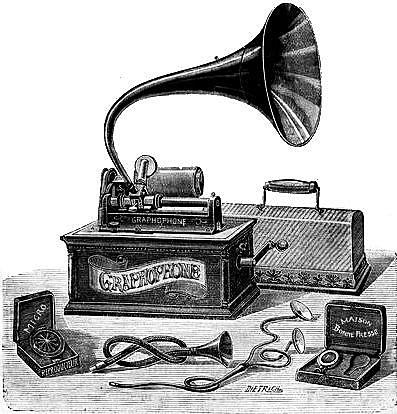BLOG #5 WEEK 4, Pt. 1: EOTO Com Tech Timeline The Phonograph
Edison Cylinder Phonograph
The Cylinder Phonograph was invented by 1877 the great Thomas Edison, a machine that played music by capturing sound on tin-foil-covered cylinders that spun by turning a crank. The invention brought music into the homes, the granddad physical music media we see today in vinyls. During this time music was only played at plays, bands, and concerts, if you wanted to listen to music at home you had to learn the music yourself by playing the piano. Pianos were seen as a luxury item, it was expensive and not everyone could afford one or get lessons to learn how to play it. The Cylinder Phonograph worked because sound waves vibrated the needle that recorded the sound waves when you speak into it, the message you said into the mouthpiece was played back when the play button was pressed. History of the Cylinder Phonograph Thomas was experimenting with ways to transcribe telegraphic messages with intentions on a paper tape, which he believed could work the same way telephone messages did.
Edison Disc Phonograph
But the more widely known Phonograph is the disc model that was an improvement on the earlier model instead of using a tin cylinder that was expensive at first but years later it became cheaper for consumers to buy. However the Cylinder had limitations only recording 2 mins and could not duplicate between other Cylinders, so artists had to record their songs which was costly and time-consuming. Fearing the competition from other disc manufactures a Disc based models were created by price and at first the public's reaction was middling at best. Edison's Discs did not work on other competitors Phonograph's and only can be used by Edison's Phonographs. WWI lead to a decline in sales, lucky the company was able to sell to American soldiers to be brought with overseas to be used as answering machine than playing music. After the war sales spiked during the roaring 20s jazz music playing Speakeasy's and just having a good time, sure prohibition was enacted and was easily circumvented because of lack of enforcement in certain areas.
While Phonographs were used to have physical media for music, the greatest threat was the radio you didn't have to buy records from record labels when the radio station used the same discs and plays it on the radio. The radio did not outright kill the Phonograph but consumer tastes change to have a wide variety of Songs, News Sports and podcasts which the Phonograph just could not compete in. I felt this happened not too long ago when mp3 file sharing exploded in popularity via Limewire in the early 2000s record companies, bands did not like it one bit. It showed that there was a demand from consumers that wanted an easy way to access music cheaply other than buying CD's in turn made the iPod a success. Today, physical music still has a fan base like vinyls. However a song could be taken down on a streaming service and people would be unable to listen to that song without physical media because streaming services treat users as a license. Phonograph Disc


Comments
Post a Comment